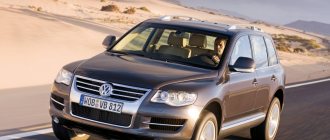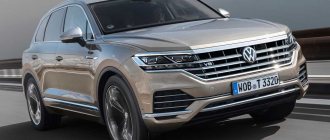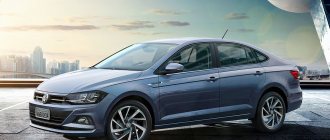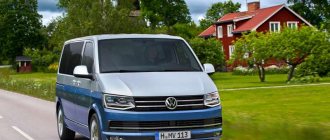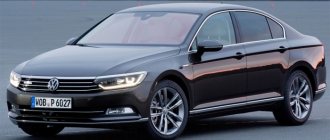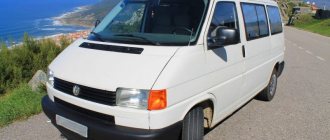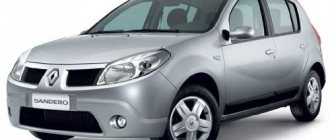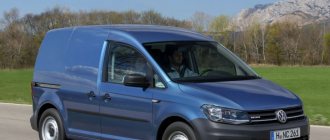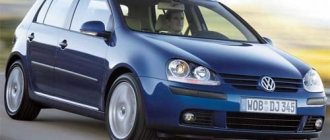dimensions
As befits a representative of the mid-size crossover class, the Tuareg does not suffer from minimalism. This is understandable, the inhabitants of such cars do not pay money to warm their ears with their knees, huddled in the car. And the space inside requires dimensions outside; auto designers have not yet been able to bypass the laws of physics.
Latest materials
About the trunk of the Volkswagen Touareg 3: useful accessories for the car owner
Brake pads Volkswagen Touareg 3
External dimensions
| Length, mm | 4 878 — 5 008* |
| Width along body sides, mm | 1 984 |
| Width of exterior mirrors, mm | 2 193 |
| Height, mm | Max. 1,717 |
| Wheelbase, mm | 2 904 |
| Approach/departure angles, degrees | 23,3/17,2 |
| Ramp angle, degrees | 13,5 |
| Front wheel track (at the middle of the tires), mm | 1 653 — 1 669* |
| Rear wheel track (at the middle of the tires), mm | 1 669 — 1 685* |
| Height of the open tailgate edge, mm | 2 131 |
| Ground clearance (ground clearance) , mm | 237** |
* - the min and max values are indicated through a dash if there are differences in different configurations.
**- for basic. If an air suspension is installed, the ground clearance is variable, maximum 300 mm.
Domestic
Interior dimensions | |
| Interior width in the first / second row, at knee level, mm | 1 584 / 1 547 |
| Height from seat cushions to ceiling on first/second row, mm | 1 049 / 990 |
Trunk dimensions | |
| Length (from the beginning of the trunk to the back of the rear seat), mm | 1 051 |
| Length (to the back of the front seat), mm | 1 910 |
| Volume with rear seat backrests raised/folded, l | 810 / 1 800 |
Vehicle weight
The curb weight of the Tuareg is 2,040 kg.
Fuel consumption of the third generation Volkswagen Touareg.
TDI 3.0
- city - 8.8 liters per 100 km;
- highway – 6.5 l per 100 km;
- mixed mode - 7.4 liters per 100 km.
2.0 TSI
- city - 10 liters per 100 km;
- highway - 7.1 l per 100 km;
- mixed - 8.2 per 100 km;
3.0TSI
- city - 11.5 l per 100 km;
- highway - 7.6 l per 100 km;
- mixed - 9.1 per 100 km;
I don’t know how calmly and smoothly you need to drive to get these numbers, but in theory you can see them on the dashboard.
Power unit
There is no alternative for the Russian market; other engines are not provided. Consists of a turbodiesel and hydromechanical gearbox.
TDI 3.0 engine: V-shaped, turbocharged, 6-cylinder.
| Working volume, cm cubic | 2 967 |
| Maximum power, l. s./at rotational speed, rpm | 249/3 000 — 4 500 |
| Maximum torque, Nm/at rotational speed, rpm | 600/1 500 — 2 750 |
Automatic transmission-8: it was once the first hydromechanical transmission with 8 steps. Thanks to such a large number of them, the automatic transmission is equal in efficiency to the manual transmission, since the engine can operate almost all the time in the optimal speed range.
| Transmission | Hydromechanical |
| Gearbox (brand, type) | Automatic, with the ability to switch to manual control. |
| Transfers | forward – 8, backward – 1 |
| Gear ratios | |
| I | 5.070 |
| II | 2.972 |
| III | 1.950 |
| IV | 1.470 |
| V | 1.231 |
| VI | 1.000 |
| VII | 0.808 |
| VIII | 0.672 |
| Z.H. | 4.003 |
Dynamics and consumption
- maximum speed - 230 km/h;
- acceleration from 0 to 100 km/h - 6.8 seconds;
- city consumption - 8.2 l/100 km;
- highway consumption - 6.5 l/100 km;
- in mixed mode - 7.1 l/100 km.
It is noteworthy that the diesel engine is quite economical, despite the considerable size and weight of more than 2 tons of the Tuareg. But at the same time, if necessary, it provides very fast acceleration.
All-wheel drive , 4Motion. It can be supplemented with a system for monitoring and controlling the transmission of torque to the drive wheels, which allows, in the event of loss of traction with one wheel, to maintain the supply of torque to the others.
What diesel engines are installed on the Touareg
Experts and car enthusiasts say that the best diesel engine in the Tuareg is 3 liters with 240 hp. But this is not the only type of motor that is installed on these models. What a diesel Volkswagen Touareg engine might be like is clear from the table below.
| Power, hp | Volume, l | Transmission | Year of issue | Brand | Price, rubles |
| 163 | 2,5 | Manual transmission, automatic transmission | 2002, 2006 | BLK, BPD | |
| 174 | 2,5 | Manual transmission, automatic transmission | 2002, 2006 | BAC, BPE | 400,000 (used) |
| 225 | 3,0 | Manual transmission, automatic transmission | 2002 | BKS, CATA | |
| 220 | 3,0 | Automatic transmission | 2002 | BKS, CATA | |
| 313 | 4,9 | Automatic transmission | 2002, 2006 | AYH, BLE, BWF | |
| 224 | 3,0 | Automatic transmission | 2006 | BKS, CATA | 670,000 (used) |
| 240 | 3,0 | Manual transmission, automatic transmission | 2006 | CASA, CASC | |
| 351 | 4,9 | Automatic transmission | 2006 | CBWA | 525,000 (used) |
| 204 | 3,0 | Automatic transmission | 2010, 2014 | CASD, CJMA | 2,390,000 (used) |
| 240 | 3,0 | Automatic transmission | 2010 | CNRB, CASA | |
| 245 | 3,0 | Automatic transmission | 2010, 2014 | CJGD, CRCA | 1,799,000 (used) |
| 340 | 4,1 | Automatic transmission | 2010, 2014 | CKDA | 1,900,000 (used) |
| 249 | 2,0 | Automatic transmission | 2018 | CYRC | 4,571,000 (new) |
| 249 | 3,0 | Automatic transmission | 2018 | CVMD | 5,449,500 (new) |
The most popular model among car owners is the Touareg 3.0 diesel. Models with such an engine have an optimal combination of power, performance, fuel consumption, and ease of maintenance. The Tuareg 2.5 diesel is slightly less popular, but it is also a favorite of Russian drivers who prefer luxury crossovers.
Photo Touareg V8 TDI
Specifications
Reviews about the Volkswagen Touareg diesel SUV are different, but most of the owners are happy with the car. This applies to both old models and new ones released in 2021. Each model has its own technical characteristics, but for evaluation it is worth considering the model produced from 2014 to 2018 - Volkswagen Touareg 3.0 TDI.
Read also Bolt pattern Passat B5
This is a five-seater SUV, all-wheel drive, with a 3.0 liter V6 turbodiesel engine producing 245 hp. Claimed power is achieved at 3800 rpm. The car can reach speeds of up to 220 km/h. The acceleration of the Tuareg to 100 is interesting; the Tuareg diesel has a good performance of 7.6 seconds.
The model has an 8-speed automatic transmission and independent multi-link suspensions front and rear. Brakes are ventilated discs on both the front and rear wheels. Dimensions of the car – 4801×1940×1709 mm, weight 2148 kg.
Photos of Volkswagen Touareg 3.0 TDI
Claimed fuel consumption
For this model, the manufacturer indicates three modes in which the Tuareg diesel fuel consumption will be different:
- urban - 8.8 l per 100 km;
- outside the city - 6.5 liters per 100 km;
- mixed mode - 7.4 l per 100 km.
Actual consumption will vary depending on driving conditions in each mode, owner's driving style and other factors. But, as reviews of the Tuareg (3 liter, diesel) show, it consumes much less fuel than the same model with a gasoline engine.
2011 Volkswagen Touareg 3.0 TDI Clean Diesel
Suspension
On Tuareg it can be in 2 versions: standard and pneumatic.
Pneumatic allows you to adjust the ground clearance (clearance) in the range of 160-300 mm and the level of damping. There are 5 positions for clearance:
- the lowest - to facilitate boarding and disembarking and/or loading and unloading of cargo;
- low - for dynamic driving on good roads;
- normal;
- high - for off-road;
- the highest is for off-roading in difficult conditions.
The operating principle of air suspension is very simply reduced to the supply of additional air to the pneumatic elements, as a result of which the pressure in the air chambers increases, their volume increases, the rods extend upward and lift the car body above the road.
Also, the air suspension, through a level regulator, compensates for the car's roll resulting from uneven loading, pumping air from the system to the sagging side.
There are 3 damping levels: normal, soft and hard. They change by changing the opening pressure and cross-section of the bypass valves, as a result of which more or less force has to be applied to move the attachment points of the pneumatic element.
A suspension with rear axle steering effect is also available as an option. At the same time, at low speeds, the rear wheels turn in the direction opposite to the front ones, reducing the turning radius and making maneuvering easier, and when changing lanes on a highway, they turn in the same direction as the steering wheels, while the car shifts somewhat sideways.
Oil selection
It is recommended to use branded oil for Volkswagen Touareg. It has an optimal package of additives to maximize the service life of the engine. It is important to strictly adhere to maintenance schedules. For filling, it is allowed to use motor oils of other brands, for example:
When choosing a branded oil, it is important to consider tolerances. 502/505 are suitable for most engines. The grease is sold under article number G055167M4 or G055167M2 depending on the volume. For diesel engines, oil with a 504/507 approval is most often suitable in the presence of a particulate filter. If it is not available, it is necessary to use a lubricant with approval 505.01 or 506.01.
When choosing an oil, it is necessary to take into account its viscosity. The manufacturer recommends using SAE 0W30, 0W40, 5W30 oils. When selecting viscosity, it is also advisable to focus on the climatic conditions of the vehicle’s operation. In hot regions, thicker oil should be used to prevent leakage through seals and gaskets. In frosty conditions, it is recommended to use a less viscous lubricant. to make it easier to start the engine.
When determining the required viscosity, it is important to take into account not only the climate, but also the mileage of the engine. Worn engines require thicker oil. Otherwise, the lubricant leaks out and does not lubricate the rubbing surfaces well. It is advisable to pour less viscous oil into engines with low mileage to reduce fuel consumption and extend the service life of the internal combustion engine.
If you have doubts about the correct choice of oil, you can check it. To do this, unscrew the dipstick and drop grease onto a sheet of paper. It is easy to determine the condition of the oil by the stain formed. If the lubricant turns out to be unsuitable, it should be replaced as soon as possible.
Electronic equipment
Electronic systems and assistants are presented very generously, so let’s look at the most interesting ones:
- Night vision, night vision system. That's what the creators of the car called it, but, strictly speaking, because an infrared camera is used. It would be more accurate to call it thermal vision. The camera is capable of detecting heat emanating from a large animal or person at a distance of up to 130 m and displaying the image on a virtual instrument panel, warning the driver.
The downside is that if the system sees a small animal, it will be when it is too late to brake, and the foundation block in the middle of the road will not notice at all. That is, attentiveness in the dark does not cancel them in any way. - There is nothing fundamentally new in adaptive cruise with a speed limit function. Many cars are now able to maintain a distance from the car in front, take into account signs and navigate.
- Crossroads Assistant. It would be more accurate to call it when leaving a blind spot, where the driver cannot see the road behind buildings, trees, etc. and he is forced to drive out “by touch.” And radar sensors are located at the very front of the car and will begin to signal when they sense reflected radiation from an approaching vehicle.
- Traffic assistant in traffic jams and traffic jams. Although not a new product, it is a really useful thing in large cities, saving the driver from tedious monotonous operations. The system is able to control the gas and brake itself, while simultaneously keeping the car in its lane.
Maintainability of power units
The BHK engine boasts good maintainability. It has a cast iron cylinder block, which provides a good margin of safety. Most often, the engine requires only minor repairs, for example, decarbonization of valves. After capital, the resource of the internal combustion engine is 80-85% of the new power unit.
The main problem with the BAC engine is cylinder surface shedding. Car owners found a way out - the sleeve of an aluminum block. Ready-made solutions are available for sale. If the liners are installed correctly, the engine will last 300+ thousand km until the next major overhaul.
BJN and CFRA power plants are characterized by mediocre maintainability. Officially these are disposable engines. Car repair shops are reluctant to undertake repairs of BJN and CFRA, since many repairmen are not familiar with the design of engines. There are also difficulties when finding spare parts. Therefore, in case of serious damage, it is usually more profitable to purchase a contract internal combustion engine than to repair the original one.
The good maintainability of Volkswagen Touareg engines is ensured by the fact that almost all engines have a cast iron cylinder block. This, for example, is used in the design of the CASA power unit. Internal combustion engines usually require only superficial repairs. At the same time, a large margin of safety of the cylinder block ensures successful capital investment.
The most modern engines, for example CYRC, have a significant amount of electronics. This makes them difficult to repair. Not all craftsmen undertake capital work on engines of third-generation cars. At the same time, eliminating minor faults with internal combustion engines is rarely accompanied by significant difficulties.
Results and conclusions
You can’t call the Volkswagen Touareg a budget car, but you can’t even say about the money spent on it or the money thrown away. The car offers a combination of dynamics, efficiency, comfort and cross-country ability at a very good level, so it doesn’t force you to sacrifice anything. Well, of course, except for the money itself... Whether it’s worth it or not, you’ll have to decide for yourself.
Read further:
About the trunk of the Volkswagen Touareg 3: useful accessories for the car owner
Specifications and features of the Volkswagen Jetta
Briefly about the main thing: technical characteristics of the Volkswagen Tiguan
Brake pads Volkswagen Touareg 3
VW Touareg: Russian suspension options
The most reliable engine in the Volkswagen Touareg
Which engine is better to choose a Volkswagen Touareg
When choosing a Volkswagen Touareg from early years of production, it is recommended to pay attention to a car with a BHK gasoline engine. The engine cylinders are arranged in two rows with a slight camber. The design provides one common cylinder head cover. The internal combustion engine can boast of a decent service life and relative unpretentiousness to the quality of the gasoline poured.
Particular care should be taken when choosing a Volkswagen Touareg with a BAC diesel engine. The engine has an aluminum cylinder block without liners. The applied coating crumbles from bad fuel even with low mileage. In the case of a successful specimen, BAC can show a resource of up to 300 thousand km. Still, it is better to avoid purchasing a car with this internal combustion engine.
If you want to have the most powerful Volkswagen Touareg, it is recommended to choose a car with a BJN engine under the hood. The motor is capable of providing truly dynamic acceleration. The internal combustion engine perfectly emphasizes the sporty appearance of the car. With the BJN engine there will be no problems when overcoming any off-road conditions.
When choosing a Volkswagen Touareg with a CASA engine, it is important to find out whether its high-pressure fuel pump has been replaced. Early engines were recalled by the manufacturer to eliminate problems with the injection pump. In general, the engine has a long service life of more than 350-380 thousand km. The internal combustion engine boasts an optimal combination of fuel consumption and dynamic performance.
On the third generation Volkswagen Touareg, the CYRC engine performed well. It is suitable for car owners who are concerned about environmental pollution, but are not ready to give up sporty driving. The power unit is equipped with all modern Volkswagen technologies. Its declared resource is 270 thousand km, but in practice the real figure is much higher.
Tuning Volkswagen Touareg engines
Most Volkswagen Touareg engines have a huge safety margin thanks to the cast iron cylinder block. This facilitates tuning using various methods. With the right integrated approach, internal combustion engines do not lose significantly in service life and reliability. Therefore, boosting engines on Touareg is very popular.
Volkswagen power plants are strangled from the factory by environmental standards. Chip tuning allows you to unleash the built-in power. By reflashing the ECU, you can reduce fuel consumption, and not only improve dynamic performance. There are ready-made solutions for Touareg chip tuning. You should also consider the possibility of rolling back to factory settings in case of unsuccessful flashing.
Surface tuning is also popular on the Volkswagen Touareg. Car owners use lightweight, high-strength pulleys. You can often find a zero-resistance or forward-flow air filter. Superficial tuning allows you to add up to 5-15% of the original power.
For a more impressive increase in horsepower, deep tuning is required. It involves a complete overhaul of the engine with the replacement of some parts. Uses include stock pistons, camshafts and forged crankshaft. With deep tuning there is always a risk of irreparably damaging the power plant, but the power increase can be up to 2 times.
BJN and CFRA engines are especially popular among tuning enthusiasts. Their large displacement contributes to significant boost. With an integrated approach, it is often possible to achieve 1000+ hp. At the same time, the safety margin of the internal combustion engine can easily withstand high power.
Engine swap
Volkswagen Touareg engines are very popular for swapping. They have good reliability, long service life and good maintainability. The engines are moved under the hoods of other SUVs, minivans and commercial vehicles. There are quite a lot of decent power plants on sale online.
The BJN and CFRA power plants are especially popular among swap fans. The demand for engines is justified by their high power. Motors are installed on sports cars that participate in races and races. ICEs are also used for swapping heavy SUVs.
Swap is also popular on Volkswagen Touareg. The car has a large engine compartment. Therefore, it is not a problem to place a large internal combustion engine with 6.8 or even 12 cylinders on it. The most popular for swapping on Volkswagen Touareg are 1JZ and 2JZ. Power units have a large margin of safety and are perfect for boosting.
Volkswagen Touareg cars of all generations have sophisticated electronics. This causes difficulties when conducting a swap. Car owners note that the installed motor often does not work correctly. There may be power failures or unreliable display of information on the instrument panel.
